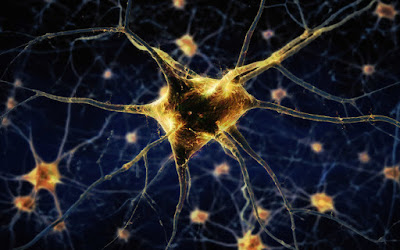From the image above, one can see that DNA can be replicated multiple times and will eventually undergo an expression called transcription. Transcription is the process "in which RNA polymerase uses one strand of DNA as a template to synthesize a complementary RNA sequence"((2) p.G:24), basically meaning that an enzyme creates an RNA strand from DNA. The newly formed RNA strand can then undergo the second expression, which is known as translation. Translation is when a nucleotide directs the amino acids to form a protein ((2) p.G:24).

http://www.dbriers.com/tutorials/2012/12/tip-to-remember-difference-between-translation-vs-transcription/
The image on the right reveals that transcription is basically transcribing a message, where you take one set of information (DNA) and rewrite the same information (RNA) to get a better understanding. The next form of expression is translation, where the RNA strand will become a protein. The image above on the left reveals that translation is like translating one language (RNA) to another that is different yet more ideal (new protein). The central dogma is important because it gives scientists a broader understanding of how genetic information is interpreted and regulated within our cells. Why should we care? 99.9% of all human DNA is the same (4). Its arranged the same and in the same order, so the question is why do some people get diseases and syndromes that others do not? That is why we should care. Not everyone's genes are expressed the same way, which is why scientists continue to do research on gene regulation. So what exactly is a gene and what does it mean that it is "expressed?" A gene is a segment of DNA that instructs the RNA strand to make a certain protein ((2) p.G:10). Gene expression is when a cell selects which proteins or RNA molecules are to be made through transcription and translation ((2) p. 262). This process is the reason why some of us have brown, red, blonde, or black hair. Gene expression is the overall name of the process, while the central dogma is each of its individual steps. Gene expression is important because it's why we have such things like brain and red blood cells. Even though each of those cells come from the same DNA sequence, they have completely different structures and functions.
The discovers associated with gene expression have led scientists to understand more about "cancer, autoimmunity, neurological disorders, diabetes, cardiovascular disease, and obesity" (3), which have all been linked to having a gene expression malfunction. How can there be a malfunction with an individual's gene expression? Generally, these types of diseases and syndromes are likely to occur when an individual's regulatory region, transcription factors, cofactors, chromatin, regulators, and/or noncoding RNAs have a mutation (3). Two examples include cardiovascular disease and diabetes. A congenital birth defect can give an individual cardiovascular disease because of a misregulation when the cardiovascular system was being created. Normally when our blood sugar level drops, the pancreas will decrease the amount of insulin being produced and will release cells that are known as glucagon. These glucagon cells make the liver turn glycogen (polysaccharide; complex sugar) back into glucose (simple sugar) so that our blood sugar level can increase and get back to normal (5). In an individual with diabetes, there can be a mutation in the “pancreatic master transcription factors and the sequences they bind” are associated with diabetes. In another scenario, the cells can have its transcription factors, like “HNF1α, HNF1β, HNF4α, PDX1, and NeuroD1,” be mutated which causes the cells to not be able to properly respond to the insulin that is produced (3). Any of these transcriptional factors can be associated with an individual having diabetes. Although our cells do malfunction sometimes during gene expression, they make us the way we are today. You could not be you without gene expression and the central dogma.
Next week: Model Organisms
References:
(1) This video shows the provides a basic understanding of the process cess that is done in the Central Dogma. Central Dogma of molecular biology. Khan Academy Medicine. https://www.khanacademy.org/test-prep/mcat/biomolecules/amino-acids-and-proteins1/v/central-dogma-of-molecular-biology-2. Accessed February 6, 2019.
(2) This is the 4th edition Essential Cell Biology textbook. Alberts, B., Bray, D., Hopkin, K., Johnson, A., Lewis, J., Raff, M., Roberts, K., Walter, P. Essential Cell Biology. Fourth Edition. New York, United States. Published by Garland Science, Taylor and Francis Group, etc. Most recent copyrights were in 2014. (p. G:24, G:10, & 262).
(3) This manuscript describes gene expression and how certain diseases and syndromes happen because of how genes are expressed. Transcriptional Regulation and its Misregulation in Disease. NCBI. https://www.ncbi.nlm.nih.gov/pmc/articles/PMC3640494/. Published March 14, 2013. Accessed February 8, 2019.
(4) This site has a video and facts about our DNA, the human genome, and how our DNA makes us unique. What are DNA and Genes? Learn. Genetics. https://learn.genetics.utah.edu/content/basics/dna. Accessed February 9, 2019.
(4) This site has a video and facts about our DNA, the human genome, and how our DNA makes us unique. What are DNA and Genes? Learn. Genetics. https://learn.genetics.utah.edu/content/basics/dna. Accessed February 9, 2019.
(5) This site describes the process of how the body regulates blood sugar levels. Healthwise staff. How the Body Controls Blood Sugar. HealthLink BC. https://www.healthlinkbc.ca/health-topics/uf6060. Updated May 3, 2017. Accessed February 13, 2019.








No comments:
Post a Comment